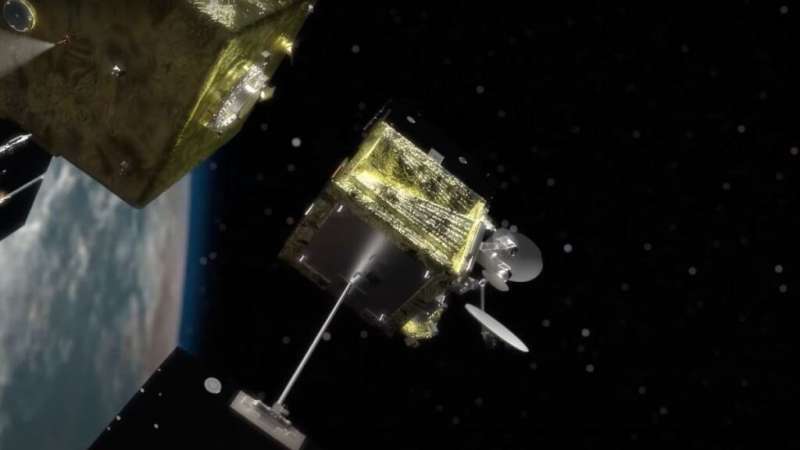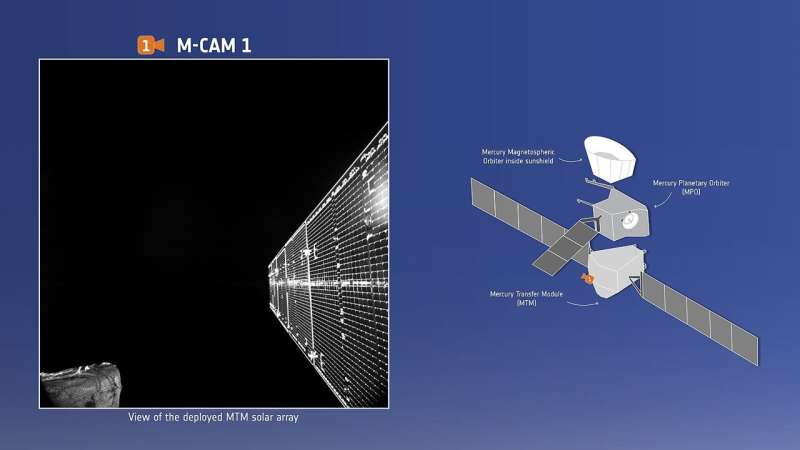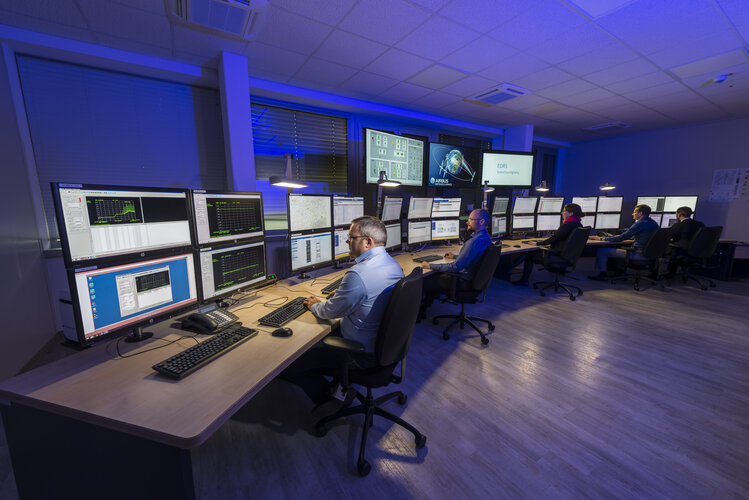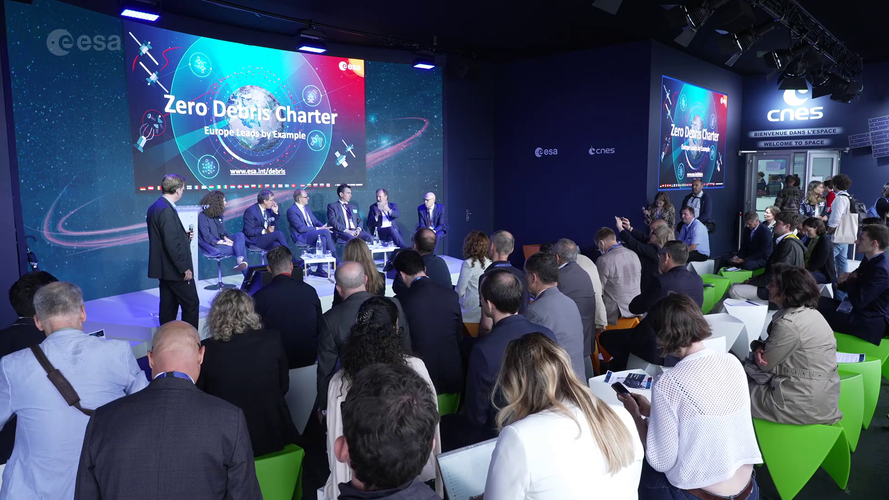
Copernical Team
A new mission will grab dead satellites and push them into the atmosphere to burn up

Plenty of news stories have focused on the danger posed by Kessler syndrome. In this condition, space is made inaccessible by a cloud of debris surrounding our planet that would destroy any further attempts to get into orbit. Therefore, plenty of companies have sprung up to take care of the problem, from blasting derelict satellites with lasers to helping to refuel them—lots of business models have been created to capture this opportunity.
One of the farthest along is Astroscale. This British start-up is tackling the problem with one of the more conventional techniques—linking up with an existing satellite to deorbit it. And recently, they released a promotional video for their new project—the ELSA-M.
ELSA-M, which stands for End of Life Services by Astroscale-Multiple, is designed to couple with an existing satellite, force it into a lower orbit, and make it reenter more quickly. It will be the first satellite to boost itself up to another orbit for a second rendezvous and deorbit that second satellite as well.
Video: BepiColombo's third Mercury flyby

Watch Mercury appear from the shadows as the ESA/JAXA BepiColombo spacecraft sped by the planet's night side during its 19 June 2023 close flyby, and enjoy a special flyover of geologically rich terrain.
In the first part of the movie, composed of 217 images captured by BepiColombo's monitoring camera M-CAM 3, the planet's illuminated side quickly appears in the spacecraft's field of view, showing off a bounty of geological features on its surface. The planet's terminator—the divide between day and night—becomes more distinctive from afar, adding to the beauty of the image sequence. At one point Mercury momentarily appears to hang between the spacecraft's body and antenna before the spacecraft speeds away.
The image sequence starts from 19:46:25 UTC on 19 June 2023, at an altitude of 1,789 km above the planet's surface, and ends at 20:34:25 UTC on 20 June 2023, when BepiColombo was 331,755 km away.
Relay system speeds vital data flow with 75,000 links

Life-saving data that enables European governments to respond rapidly to crises is flowing swiftly from space to Earth, thanks to the most sophisticated space-based laser communication network ever built.
Paris Air Show Live - Press briefing on new European Zero Space Debris policy
 Video:
00:46:00
Video:
00:46:00
Watch the replay of the live session from Paris Air Show 2023 discussing the signature of a new European Zero Space Debris policy. ESA's aim is to totally stop the generation of debris in valuable orbits by 2030. This approach has been initiated by the Agency in response to the catastrophic degradation of the Low-Earth Orbit environment. Speakers will include ESA representatives -including its Director General- and leading industry players.
Paris Air Show Live – Session on understanding Earth’s water and carbon cycles from space
 Video:
01:08:04
Video:
01:08:04
By using concrete examples of the water and carbon cycles, the speakers in this session focus on the grand science questions and how we can turn them into answers and solutions most useful to decision-makers at the front line of the climate crisis. Earth is a highly dynamic system where the transport and exchanges of energy and matter are influenced by a multitude of processes and feedback mechanisms. Untangling these complex processes to better understand how Earth works as a system is a major challenge; a challenge that satellites, with their global view, are ideally positioned to
W-band on the run
 Image:
W-band on the run
Image:
W-band on the run Evidence of the amino acid tryptophan found in space
 Using data from the Spitzer space observatory, Dr Susana Iglesias-Groth, a researcher from The Instituto de Astrofisica de Canarias (IAC), has found evidence for the existence of the amino acid tryptophan in the interstellar material in a nearby star-forming region. The research is published in Monthly Notices of the Royal Astronomical Society.
High amounts of tryptophan were detected in t
Using data from the Spitzer space observatory, Dr Susana Iglesias-Groth, a researcher from The Instituto de Astrofisica de Canarias (IAC), has found evidence for the existence of the amino acid tryptophan in the interstellar material in a nearby star-forming region. The research is published in Monthly Notices of the Royal Astronomical Society.
High amounts of tryptophan were detected in t New study weighs the universe's supermassive black holes
 Near the center of the Milky Way Galaxy sits an immense object that astronomers call Sagittarius A*. This "supermassive" black hole may have grown in tandem with our galaxy, and it's not alone. Scientists suspect that similar behemoths lurk at the heart of almost all large galaxies in the cosmos.
Some can get really big, said Joseph Simon, postdoctoral researcher in the Department of Astro
Near the center of the Milky Way Galaxy sits an immense object that astronomers call Sagittarius A*. This "supermassive" black hole may have grown in tandem with our galaxy, and it's not alone. Scientists suspect that similar behemoths lurk at the heart of almost all large galaxies in the cosmos.
Some can get really big, said Joseph Simon, postdoctoral researcher in the Department of Astro Seven US companies collaborate with NASA to advance space capabilities
 NASA will partner with seven U.S. companies to meet future commercial and government needs, ultimately benefitting human spaceflight and the U.S. commercial low Earth orbit economy.
Through unfunded Space Act Agreements, the second Collaborations for Commercial Space Capabilities-2 initiative (CCSC-2) is designed to advance commercial space-related efforts through NASA contributions of tec
NASA will partner with seven U.S. companies to meet future commercial and government needs, ultimately benefitting human spaceflight and the U.S. commercial low Earth orbit economy.
Through unfunded Space Act Agreements, the second Collaborations for Commercial Space Capabilities-2 initiative (CCSC-2) is designed to advance commercial space-related efforts through NASA contributions of tec An amino acid essential for life is found in interstellar space
 Tryptophan is one of the 20 amino acids considered essential for the formation of proteins, which are key macromolecules for the development of life on Earth. This amino acid has many spectral features in the infrared, as had been previously characterized by Susana Iglesias Groth, an IAC researcher.
Using data from the Spitzer Space Observatory she identifies more than 10 emission bands of
Tryptophan is one of the 20 amino acids considered essential for the formation of proteins, which are key macromolecules for the development of life on Earth. This amino acid has many spectral features in the infrared, as had been previously characterized by Susana Iglesias Groth, an IAC researcher.
Using data from the Spitzer Space Observatory she identifies more than 10 emission bands of 
